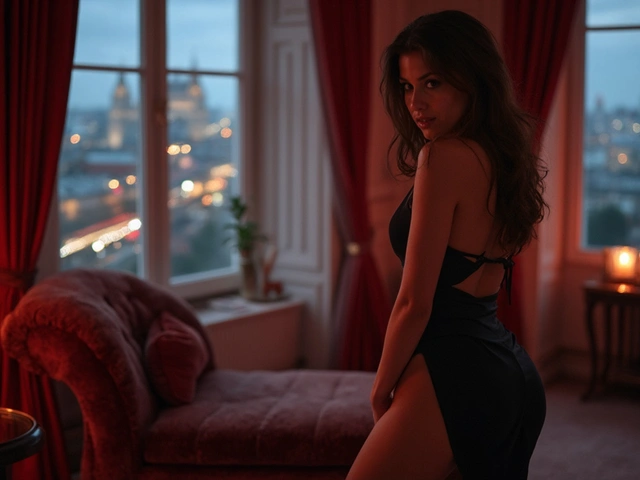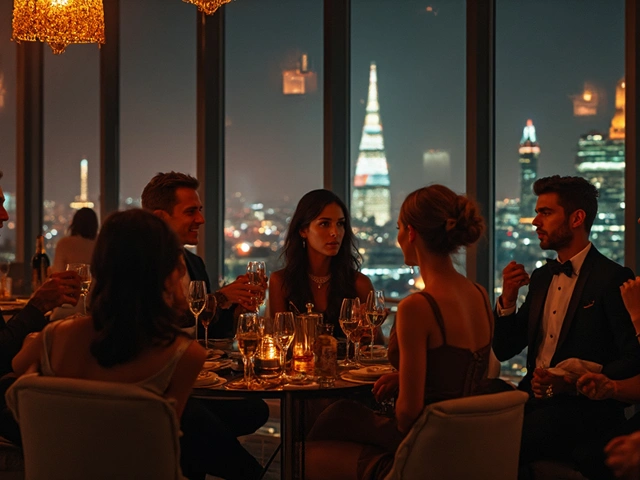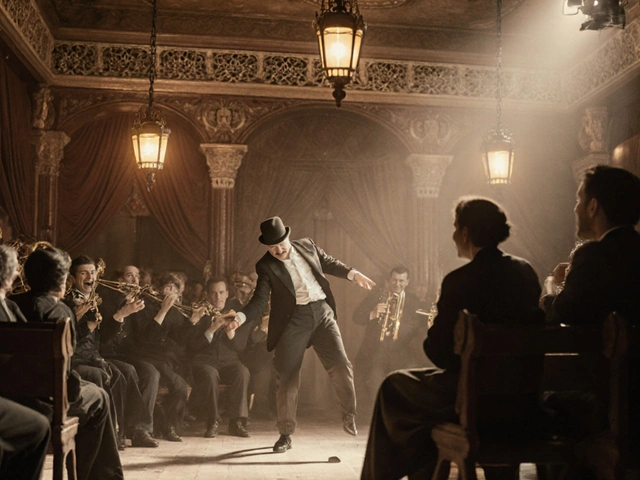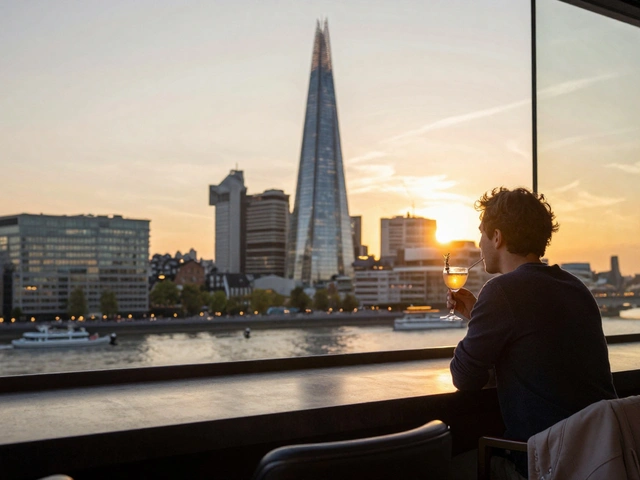Anyone wandering through Soho or Shoreditch today probably takes London’s cocktail lounges for granted. But rewind a few decades, and grabbing an Old Fashioned wasn’t as easy as tapping a contactless card at Swift or Nightjar. In London, cocktail bars have always mirrored the city’s moods—whether it’s the wild excess of Victorian gin palaces or the secrecy of wartime watering holes.
Visiting a cocktail lounge in London isn’t just about sipping a drink; it’s about stepping into a space full of stories and tradition. The best spots often hide behind unmarked doors or below ground level. Take The Connaught Bar in Mayfair—world famous, but still feels discreet. Or try trickier finds like Discount Suit Company, tucked near Liverpool Street. London’s history means its bars aren't just places to drink, but living museums shaped by smuggled spirits, jazz records, and more than a little rule-breaking.
If you’re new in town (or just stuck in a rut), don’t let the endless choices knock you back. The scene’s exploded since the 2000s, but some lounges stick to classic service, while others dream up wild, Instagram-bait concoctions. Know the dress codes—some West End lounges won’t let trainers through the door, while Hackney locals might raise an eyebrow at a suit. Every neighbourhood has its quirks, from fancy hotel bars to casual speakeasies, so it pays to match your mood with your destination.
- From Gin Palaces to Wartime Hideouts
- Swinging Sixties and the Birth of Modern Mixology
- Contemporary Cocktail Culture in London
- Tips on Navigating the City's Best Lounges
From Gin Palaces to Wartime Hideouts
Big, bright, and bustling—the original gin palaces of London were the 19th-century answer to our modern cocktail lounges. Picture glass chandeliers, shiny brass, and walls covered in mirrors. Gin was king and cheap, so places like the Princess Louise (which still stands in Holborn) became hotspots for workers needing a pick-me-up. By the numbers, Londoners in the 1830s drank over 50 million gallons of gin a year. That’s not a typo. It set the foundation for what we think of as communal city drinking.
The gin craze wasn’t just about excess—it shaped the look of British pubs and lounges. The eye-popping interiors were a clever ploy to lure in customers, making ordinary nights feel special. Many surviving pubs and lounges trace their layouts back to this era. Try a walking tour from Charing Cross to Covent Garden, and you’ll spot original Victorian features, from etched glass panels to ornate bar counters.
Then came the 20th century and things got a bit more hush-hush. The two World Wars forced bars and cocktail lounges into survival mode. Rationing meant fewer ingredients; blackout rules made for low-lit, often hidden drinking dens. Officially, London’s public bars shut early, but go on a history crawl today and you’ll hear stories of secret knocks and hidden basements, especially around Soho and Fitzrovia. The legendary Bar Americain under Zédel still channels this clandestine vibe.
Here’s a handy snapshot of how London’s bars handled the gin rush versus wartime squeeze:
| Era | Main Features | Popular Locations | Drinks of Choice |
|---|---|---|---|
| Gin Palace Era (1830s-1900) | Ornate decor, open to the street, cheap gin | Holborn, Covent Garden, Marylebone | Gin, London Porter, basic cocktails |
| Wartime Hideouts (1914-1945) | Low lighting, hidden rooms, rationed spirits | Soho, Fitzrovia, The West End | Whisky, portable cocktails, black-market spirits |
If you want to explore this history, pop into classic haunts like the Lamb & Flag in Covent Garden or hunt down retro-themed bars offering menu nods to wartime recipes. Today’s London cocktail lounges owe a lot to these earlier chapters, from their look to their playful secretiveness. And if you’re scouting a spot with real heritage, picking one that was around in the gin palace days is basically a guarantee for character—and some wild stories from the staff.
Swinging Sixties and the Birth of Modern Mixology
The 1960s in London were wild. Think mini-skirts, The Beatles, Carnaby Street—and the city’s cocktail lounges shaking things up too. Bars shed that old stiff-upper-lip vibe. Suddenly, drinks were brighter, bolder, and the music was twice as loud. Soho turned into the epicentre of after-hours fun, with spots like The Colony Room Club drawing artists and musicians after dark. It’s no exaggeration—the capital’s nightlife scene rewrote the rulebook.
Cocktails in London started to look—and taste—different. Mojitos, Mai Tais, and Piña Coladas replaced dusty old port or whisky neat. Barmen (they weren’t really called “mixologists” yet) began mixing with imported spirits, canned juices, and even those little paper umbrellas. Tiki bars like Trader Vic’s inside the London Hilton Park Lane opened up, drawing crowds who wanted to drink something other than gin and lager. The whole atmosphere got way more relaxed and inclusive.
Here’s what made the 60s such a game-changer for London cocktail culture:
- New drinks: Vodka overtook gin as the spirit of choice (no small feat in England!).
- Changing tastes: Sweet, colourful cocktails fitted the playful mood of the times.
- Pop culture: TV and movies—think James Bond with his shaken-not-stirred martini—turned cocktails into must-have accessories for nights out.
- Venue style: Spaces got hipper. Velvet booths, neon lights, and modern art replaced smoky wood panelling.
The swinging scene wasn’t just hype. Check out some real numbers about nightlife back then:
| Year | Registered Bars (Greater London) | Imported Vodka Volume (litres) |
|---|---|---|
| 1960 | 1,200 | 15,000 |
| 1966 | 1,800 | 38,000 |
| 1970 | 2,400 | 55,000 |
One great hack? If you want to re-live the era, search for ‘retro bars’ in Soho—bars like Bar Américain or Zebrano play on that throwback vibe. Order a Tom Collins or an Espresso Martini (which Londoners later claimed for their own) and soak up the nostalgia. The sixties taught the city that drinks can be fun and unexpected—something modern London keeps proving, night after night.

Contemporary Cocktail Culture in London
London’s cocktail lounges aren’t just lining up gin and tonic these days—they’re leading the charge around the world. The cocktail scene here has totally transformed since the early 2000s. Today, if someone talks about London cocktail lounges, you know they’re thinking about quality drinks, creative menus, and bartenders who treat shaking a Negroni like an art form. In 2024, more than 12 London bars made it to the “World’s 50 Best Bars” list—no other city came close.
What’s really driving the scene? Ingredients matter now. Bartenders are swapping out boring mixers for homemade syrups, local herb infusions, or even foraged botanicals. Think of Lyaness on South Bank, where the cocktails come with wacky names and custom “cordials” made in-house. Or check out Tayēr + Elementary in Shoreditch—these folks use seasonal produce so the drinks change all the time, and there’s zero-waste thinking behind the bar.
Sustainability is big. Most top lounges are ditching single-use plastics, slinging paper or metal straws instead, and some (like The Artesian at The Langham) have green initiatives—using leftovers for infusions or garnish. Customers care, too. According to a 2023 UK Hospitality survey, 71% of under-35s in London said eco-friendly practices influenced their choice of where to drink.
| Bar | Neighbourhood | Top Feature |
|---|---|---|
| Lyaness | South Bank | Homemade cordials, inventive drinks |
| Tayēr + Elementary | Shoreditch | Seasonal menus, sustainability |
| Swift | Soho | Classic cocktails, live jazz nights |
| The Connaught Bar | Mayfair | World-famous martini trolley |
Unlike the stuffy old hotel bars, you’ll spot more casual vibes these days. Many places allow walk-ins and don’t expect you to wear a jacket—though you might want to check their Instagram first just in case. There’s a ton of pop-up bars inspired by streetwear brands or themed around local music scenes, especially in East London. And you’ll see more lounges offering non-alcoholic or low-ABV options—Seedlip and Æcorn spritzes are standard in places like Nine Lives by London Bridge.
If you want to try out the best of what’s happening, head out midweek. You’ll skip the queues and get to chat with bartenders who’ll tell you the story behind every drink. Some even host workshops—TT Liquor on Kingsland Road will teach you to mix your own classics or spin a new flavour combo. London’s cocktail culture is about experimenting, learning, and enjoying the ride—one sip at a time.
Tips on Navigating the City's Best Lounges
Hunting for the perfect London cocktail lounges vibe can be overwhelming, but it’s easier with a bit of inside knowledge. Every neighbourhood has its own hidden favourites, and knowing a few ground rules makes a big difference to your night out.
First off, reservations matter—especially west of Tottenham Court Road. At buzzy hotspots like The Connaught Bar and Dandelyan (now Lyaness), last-minute walk-ins almost always get turned away after 7pm, especially on weekends. Meanwhile, local gems like Skehan’s in Nunhead or Happiness Forgets in Hoxton are friendlier but can fill up fast too. Click-and-book is the standard; many bars don’t even answer phones after opening time. Book a week ahead if you can, especially for Friday or Saturday nights.
Dress codes still hold in some traditional spots. Hotel bars often expect smart shoes and shirts, not just because of old-school rules but thanks to a steady flow of business clients, especially around Mayfair and Canary Wharf. In contrast, somewhere like Satan’s Whiskers in Bethnal Green is more relaxed—jeans and trainers are standard, but don’t show up in a football shirt or you might not get in.
Check the menu before you go. London menus can be creative and even intimidating. Some bars (like the legendary Nightjar) offer themed lists—Prohibition classics, or drinks inspired by local history. Don’t be afraid to ask the bartender for advice. British bartenders often know their stuff and will happily suggest off-menu twists or help you avoid tourist traps. As Max Venning from Three Sheets puts it:
“London’s best bars always know how to read the room—you want something familiar, or you want to go way off-piste, they’re ready for you.”
Transport matters more than you’d think. Lounges around Soho, Covent Garden, or Old Street have great late-night tube links, while some east or south London favourites may mean a cab ride home. If you’re planning a lounge crawl, stick to one area—hopping between Brixton and Marylebone in one night is more trouble than it’s worth.
- Arrive early if you want a seat. Many places ditch bookings after 15 minutes.
- Most bars add a 12.5% service charge, and tipping on top is up to you.
- Check social feeds for one-off events or secret pop-ups—they’re huge in London, especially during London Cocktail Week each October.
- If you’re after quiet, skip the obvious busy nights; try Mondays or Sundays for a calmer experience and a chance to actually chat with the bartender.
Whether you’re looking for a low-key booth with world-class martinis or a high-energy spot for date night, you’ll never run out of new hangouts. It’s worth being curious and a bit adventurous—London’s lounge scene rewards people who ask questions and try something different from the standard pint or glass of wine.







